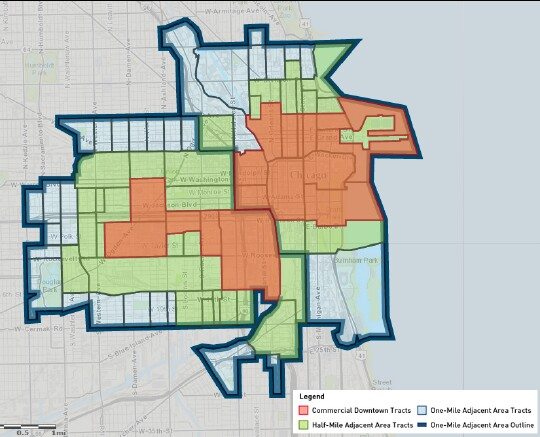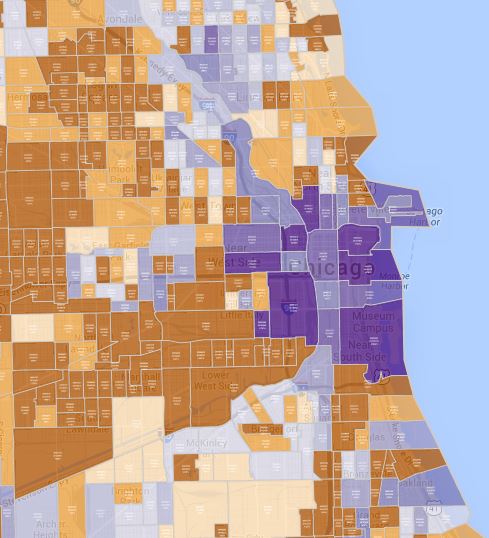Anyone who has observed the construction in Chicago over the last decade could tell you that the population has been growing near Chicago’s downtown area – however you define downtown. But somehow, up until now, I had missed the actual numbers on this trend. It wasn’t until I looked at a recent report from the Philadelphia Center City District for the International Downtown Association that I learned that over the last decade the Chicago population residing within the commercial downtown area grew by 95.6%, and by 45.5% within 1/2 mile of that area and by 46% within one mile of that area. That appears to be the largest percentage growth of all the cities for which this type of data was provided in the report. And all this occurred at a time when overall Chicago lost about 200,000 people – a decline of 6.9%.
The map below shows how the report authors defined Chicago’s commercial downtown area and the surrounding 1/2 mile and 1 mile vicinities. The brown area is the downtown area, the green area is the 1/2 mile vicinity and the blue area expands it to 1 mile. Roughly speaking, the northernmost boundary is North Avenue, the Western boundary is Kedzie, the southern boundary is Cermak, and only fish live in the lake. It’s a pretty big area. If you click on that map it will take you to the original, interactive version but you will first have to select Chicago from the dropdown list.
Exactly how the report authors came up with these boundaries is not exactly explained, though it has something to do with job density. If you want to read all about the history of defining these areas and all the challenges but never get an EXACT explanation of how they defined these areas you are free to download the entire report here: Downtown Rebirth, Documenting The Live Work Dynamic in 21st Century US Cities.
Chicago is not unique in exhibiting this increasing population concentration in the central business district. According to the report:
Nearly all of the most heavily populated downtowns saw double-digit population growth in and around their city centers…The new urban growth narrative is driven by demographics, energy costs, and cultural and business trends that are favoring dense, walkable, transit-oriented places.
Some of the other interesting findings from the report include:
- Chicago has the second highest % of workers living within one mile of downtown who work within one mile of downtown at 51.8%. No surprise, Midtown Manhattan has the highest.
- Downtown Chicago has the 3rd highest density of jobs (jobs per acre) in the nation.
In researching this post I stumbled upon an even cooler population growth map for Chicago that the Chicago Tribune created and I have included a snapshot below that you can click on to go to the original. What’s nice about it is that it breaks the population growth down by census tract, which is a pretty granular level, and without any other artificial boundaries it just shows you where the population is growing. Dark purple corresponds to near 100% growth, while dark brown corresponds to a 10% loss of population. If you look at the map you will see that the growth areas are basically concentrated east of Ashland, maybe even Racine, south of Chicago Ave, and north of Cermak, or 16th as you move further west. A lot of this reflects the South Loop boom of the last decade.
Personally I find this whole trend a bit perplexing. I totally understand people’s desire to reduce their commute time and expense but with that comes higher housing costs and the hidden cost of congestion. At some point getting basic goods and services into and out of a high density area becomes a real problem. Witness the beverage trucks blocking traffic as they make their deliveries in the middle of rush hour. And people will tell you that higher density offers economies of scale in the infrastructure required to support that population but then there is the challenge of maintaining the infrastructure in a high density area. Streets have to be torn up to do it, lanes have to be cordoned off at construction sites, and they have to drive 40 foot flatbeds loaded with construction materials into the downtown area. It’s a real mess.
Maybe I am biased by having grown up in Dallas where no one lived downtown until recently but I guess there is no denying the data. The desire to be close to jobs and entertainment seems to override all other considerations for the time being.
If you want to keep up to date on the Chicago real estate market, get an insider’s view of the seamy underbelly of the real estate industry, or you just think I’m the next Kurt Vonnegut you can Subscribe to Getting Real by Email. Please be sure to verify your email address when you receive the verification notice.

